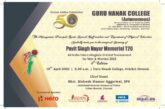COURTESY:PITCH VISION ACADEMY
© Copyright miSport Holdings Ltd 2008 Posted by David.Hinchliffe
© Copyright miSport Holdings Ltd 2008 Posted by David.Hinchliffe
To improve your cricket power you need to train in a highly specific way. That means doing exercises and routines that strengthen your whole body in ways that can be transferred to the cricket pitch.
I have discussed this before without mentioning specific exercises so today I’m going to give you the 10 most important to you.
These core exercises are not a plan in themselves, just a way to balance all your training while staying specific. You would struggle to do them all in one workout. Split them (or variations of them) over 2-4 sessions as part of your yearly cricket fitness plan.
- Squat. The plain old squat is a strength standby. You can do it with bodyweight, dumbbells or a barbell and it trains your hip mobility, legs, shoulders and trunk in one go. It’s a tough exercise but will get you great improvements if done with the right technique.
- Single Leg Squat. Training one leg at a time is a great way to develop strength, balance and sprint speed in one go. There are loads of ways to do this exercise with weight or without so pick something that challenges you.
- Romanian Deadlift. Your hamstrings exist in cricket to extend your hip while you run. The Romanian Deadlift trains you in the same way and helps prevent injury. Good form is vital here, as is keeping the weight low. No prizes for ego lifting in this game.
- Cook Hip Lift. The buzz word in sports conditioning at the moment is prehabilitation: the prevention of injury through specific exercises. The Cook Hip Lift is a hamstring and hip exercise that teaches your muscles to ‘fire’ in the right way while you are running. It’s easy to do once mastered and can be done almost anywhere which is especially good for fielders and fast bowlers who want to warm up to run while on the field.
- Medicine Ball Throws. Core stability is another one of those buzz words. In this case, the point of it is tostrengthen and activate the muscles that allow you to twist your trunk and drive power through your hips. A skill that all cricketers (especially seam bowlers) will benefit from. The key is to use a light ball (3kg or so) and throw harder. You can use a partner or a wall to help.
- Press Up. Possibly the most unglamorous and underrated exercise in the world, the press up is a superb chest, arm and trunk stability exercise. There are loads of variations such as adding a handclap for power and you can do it with no equipment at all. Forget the PE teacher who used it as a punishment, pressing up is amazing.
- Standing Overhead Press. While cricketers generally should avoid specific “shoulder exercises” (especially upright rows and lateral raises), the overhead press and its variations are essential if used in moderation. Always do them standing up and to add power drive the weight upwards with your legs as well as your shoulders and arms.
- Chin Up. The best back exercise on the market and it’s free to use. Chin ups can be hard to do for some people but with perseverance, time and assistance (from bands or a training buddy) anyone can do a few. It’s worth it because it works so many upper body muscles in one go saving you a lot of time.
- Bent Over Rows. Rowing isn’t just for rowers: they work your back muscles in a different way (vertically instead of horizontally) so develops the stabilising muscles in your hips and shoulders. They are also the perfect opposite to press ups allowing you to develop strength and power in balance. To develop even more hip rotational strength you can do it with a cable pulley system in the gym.
- Hang Pull. This power exercise is an easy to learn variation of the hang clean. To work properly it does require a relatively heavy amount of weight so is best for off season training in the gym and only with good technique. When done well it will give you big strides in power movements, especially jumping, hitting and sprinting.




